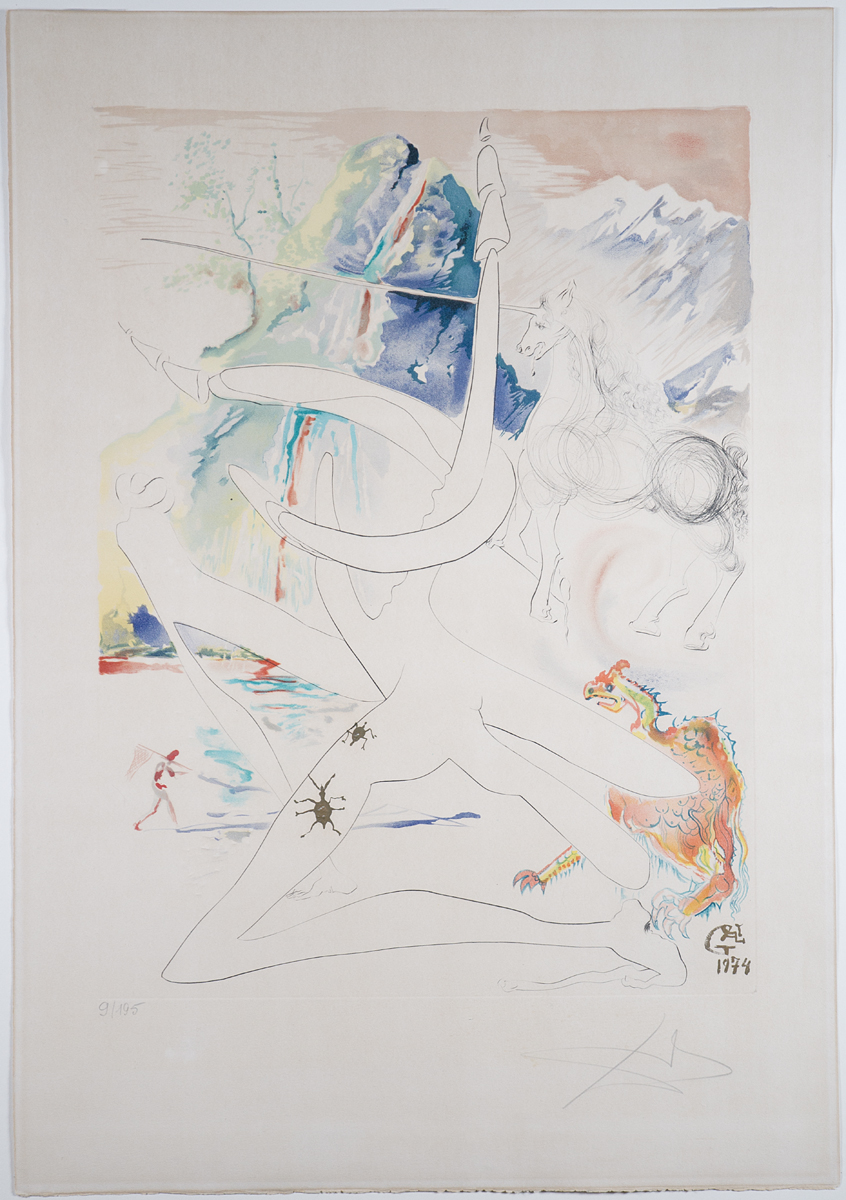Salvador Dalí
(Figueras, Gerona, 1904 - 1989)
L’Unicorne laser désintègre les cornes de rhinocéros cosmiques
1974
print (etching, drypoint and embossing) and chromolithogra on paper (9/195)
74 x 55 cm
Inv. no. P00951
BBVA Collection Spain
This series by Salvador Dalí, included in the Catalogue Raisonné of Prints II: lithographs and wood engravings 1956-1980, consists of twelve , and chromolithograph prints on Arches paper. The series was published in Paris by Jean Lavigne, who had met Dalí in Spain and expressed his deep admiration for the artist’s work at a very early stage. Lavigne asked Dalí to undertake a new project, for which he offered his collaboration. The artist, who was interested in what he called “cosmic consciousness,” embarked on the creation of this singular suite.
As a whole, these etchings showcase Dalí’s “cosmogony,” which provides room for a myriad of bizarre beings wandering through a surreal cosmic world.
Interested in Sigmund Freud’s psychoanalysis, he was particularly drawn towards the exploration of the subconscious, the study of mechanisms of repression and the role played by sexuality, as well as towards the notion of the development of personality in tune with certain psychosexual stages such as oral, anal, phallic, latency and genital, which he explored not just in this particular cycle, but throughout his whole work.
This series, of particularly complex interpretation, offers some implicit references and other rather more explicit ones, like the phallic forms and the allusions to male and female genitalia. Crutches, rhinoceroses, blood, butterflies and clocks make up a symbolic universe repeated time and again in many of his works, informing a highly recognisable iconography.
A characteristically Dalinian iconographic element is the crutch, present in nearly all this series, with the function of holding up soft structures. Dalí places it strategically to support faces or extensions of the human body. His obsession with the crutch is grounded in a childhood memory: “This object communicated to me an assurance, and arrogance even, which I had never been capable of until then.” In that regard, it has been connected to the painter’s elitism, associating it with the use of a walking stick, an object that seemed to confer a certain aristocratic countenance. His vision of that object evolved with the passing of time towards a complementary sense of “symbol of death and resurrection.” Some scholars connect the crutch with the artist’s terror of his sexual impotence.
Rhinoceroses are also present in this series. Connected to the mythological unicorn, such was Dali’s fascination with the rhinoceros that in his Diary of a Genius he wrote: “I have just discovered that, without realising it, I have painted nothing but rhinoceros horns all my life.” This evident phallic symbol is reinforced by the belief that the consumption of its powdered horn increased sexual potency.
In turn, blood, reflected in various prints of this series, has an erotic connotation for the artist. It is connected to his first intimate encounter with Gala. Blood is generally depicted as slippery and thick, as if watering the earth and satiating a symbolic thirst of eroticism and faith.
Ants, which have peopled Dalí’s work throughout his life, are one of the creatures the artist admired the most. A graphic image of sexual desire, they are also associated with putrefaction, the decay of living things, namely, with death, something that tormented and horrified Dalí.
Butterflies, also featured in Papillons de l’anti-matière, symbolize transformation and metamorphosis. In this case, the insects are the eyes of two beings that seem to merge in a representation with a strong erotic charge.
Also recurrent are soft clocks, one of Dalí’s signature symbols. They appear in the print Les montres gélatines de l’espacetemps of this series. The melting clock, as opposed to the rigid clock or watch that men are subjected to, represents the relativeness of the space-time experience. Time and space are not objective data, but dimensions of the individual experience.









